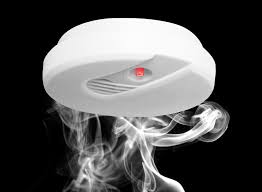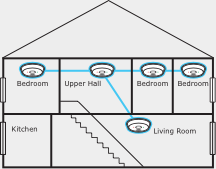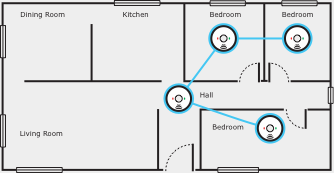New Smoke Alarm Legislation

By 2022 every home that is leased or sold needs to replace its smoke alarms with interconnected photoelectric smoke alarms.
Old ionisation smoke alarms can be slow to react, and may not give you or your loved ones enough time to escape. That’s why there’s new legislation to install photoelectric smoke alarms, which have been proven to be more effective in the domestic home.
Upgrading your smoke alarms today could save a life.
The legislation is coming out in 3 stages, the first of which has already happened. Interconnected photoelectric smoke alarms are required:
- From 1 January 2017: in all new dwellings and substantially renovated dwellings (this applies to building applications submitted from 1 January 2017).
- From 1 January 2022: in all domestic dwellings leased and sold.
- From 1 January 2027: in all other domestic dwellings.
The next deadline is January 1st 2022, which applies to any property that is going to be leased or sold.. So if you’re a Landlord, Property Manager or someone who’s looking at selling your home then this is the date that is the most important to you. For everyone else you have until 2027 to get the new system installed.
What does this mean for your home?
To comply with legislation, interconnected photoelectric smoke alarms are required:
How Photoelectric Smoke Detectors Work.
These types of detectors typically respond better to smouldering fires—essentially those that begin with a long period of smouldering. Photoelectric alarms work using a photoelectric sensor and a light source. As smoke enters the chamber and crosses the path of the light beam, light is scattered by the smoke particles, aiming it toward the sensor, which in turn triggers the alarm.
For existing dwellings that are owner occupied
From 1 January 2017
- Existing smoke alarms manufactured more than 10 years ago must be replaced with photoelectric smoke alarms which comply with Australian Standards (AS) 3786-2014. (Note: the date should be stamped on the back)
- Smoke alarms that do not operate when tested must be replaced immediately.
- Existing hardwired smoke alarms that need replacement, must be replaced with a hardwired photoelectric smoke alarm.
- It is also recommended that:
- smoke alarms be either hardwired or
- powered by a non-removable 10-year battery; and
- ionisation smoke alarms be replaced with a photoelectric type as soon as possible.
- For the best protection smoke alarms should be installed on each storey:
- in every bedroom
- in hallways which connect bedrooms and the rest of the dwelling
- if there is no hallway, between the bedrooms and other parts of the storey; and
- if there are no bedrooms on a storey, at least one smoke alarm should be installed in the most likely path of travel to exit the dwelling.
- All smoke alarms should be interconnected.
- To get everyone out safely during a house fire, it is essential to also have a well-practised fire escape plan.
From 1 January 2027
- All existing private homes, townhouses and units will require photoelectric interconnected smoke alarms. These must be either a hardwired (e.g. 240v) or non-removable 10 year battery powered type alarm.
- The legislation requires smoke alarms must be installed in the following locations:


- on each storey
- in each bedroom
- in hallways that connect bedrooms and the rest of the dwelling
- if there is no hallway, between the bedroom and other parts of the storey; and
- if there are no bedrooms on a storey, at least one smoke alarm must be installed in the most likely path of travel to exit the dwelling.
Landlords
From 1 January 2017
Landlords are responsible for the installation of smoke alarms that comply with new Smoke Alarm legislation, introduced on 1 January, 2017.
Existing smoke alarms manufactured more than 10 years ago, as well as any smoke alarms that do not operate when tested, must be replaced with photoelectric smoke alarms that comply with Australian Standard 3786–2014. All smoke alarms should be interconnected within the dwelling.
Find out more about photoelectric smoke alarms and the requirements for properties for sale or lease.
Installing smoke alarms
For the best protection, smoke alarms should be installed on each storey:
- in every bedroom
- in hallways that connect bedrooms and the rest of the dwelling
- if there is no hallway, between the bedrooms, and
- if there are no bedrooms on a storey, at least one smoke alarm should be installed in the most likely path of travel to exit the dwelling.
Any person can legally install a battery powered smoke alarm. However, 240-volt smoke alarms connect to the electricity supply and must be connected by a licensed electrician. For more information read the Smoke Alarm Installation Information Sheet.
New tenancies
Within 30 days before the start of a tenancy in a domestic dwelling, the lessor/landlord must test and clean each smoke alarm in the dwelling.
During a tenancy in a domestic dwelling, the tenant must test and clean each smoke alarm in the dwelling, at least once every 12 months.
To test a smoke alarm, press the ‘test’ button. Cleaning should be done according to the manufacturer’s instructions, which is usually vacuuming.
You do not need to be qualified or licenced to clean or test a domestic smoke alarm.
Some real estate agents may outsource smoke alarm maintenance to another company with associated fees paid by the landlord. The real estate may request a “certificate of compliance” from these companies as proof of service. This is not a legal requirement but may be part of the real estate agent’s internal process.
